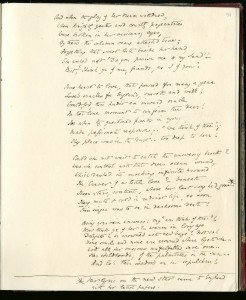Farewell, my lute!–and would that I
Had never waked thy burning chords!
Poison has been upon thy sigh,
And fever has breathed in thy words.Yet wherefore, wherefore should I blame
Thy power, thy spell, my gentlest lute?
I should have been the wretch I am,
Had every cord of thine been mute.It was my evil star above,
Not my sweet lute, that wrought me wrong:
It was not song that taught me love,
But it was love that taught me song.Letitia Elizabeth Landon
from “Sappho’s Song”
in The Improvisatrice
The above quotation was suggested by Jill Rappaport, Assistant Professor of English at The University of Kentucky, who has published several books and articles on nineteenth century women, including Letitia Elizabeth Landon. Several women writers in the nineteenth century chose the life of Sappho, a Greek lyric poet (c.610-c.580 BCE), for the focus of their poetry, finding a resonance between her plight and their own. The fragmentary nature of Sappho’s writings allowed for creativity in the way Victorian women represented her in their works. Here Landon paints Sappho as an abandoned woman, wrestling with the conflict between art and love, profession and gender, and fame and societal pressures.
Letitia Elizabeth Landon learned to read as a toddler. She published her first poem in the Literary Gazette at the age of 18, signing it simply with the initial L. The following year, she published a book of poems, The Fate of Adelaide. She frequently signed her works L.E.L. Her biographer, Laman Blanchard remarked the initials L.E.L. “speedily became a signature of magical interest and curiosity” and Bulwer Lytton reported that he and his friends would anxiously peruse the weekly publications for “the three magical letters L.E.L.” She grew to be respected among the literary community.
In 1838, just four months after she married George Maclean, Letitia was found dead, with a bottle of prussic acid (hydrogen cyanide) in her hand. The circumstances of her death are still a mystery. It is unclear whether she overdosed on her medicine, committed suicide, or was intentionally poisoned.
Previous blogs about Felicia Hemans, Anna Jameson, and Mary Shelley have highlighted the connections between nineteenth century women writers. The blog about Felicia Hemans noted that both Elizabeth Barrett Browning and Letitia Elizabeth Landon wrote poems about Felicia Heman’s death in 1835. A few years later, in 1838, Both EBB and Christina Rossetti wrote poems about L.E.L.’s death. Christina Rossetti’s poem was simply entitled “L.E.L,” and Elizabeth Barrett Browning’s poem was entitled “L.E.L.’s Last Question.” The Armstrong Browning Library owns a manuscript copy of EBB’s poem about L.E.L.
Elizabeth Barrett Browning
Autograph manuscript, with corrections
“L. E. L.’s Last Question”
Courtesy of Armstrong Browning Library
The Armstrong Browning Library owns four of Miss Landon’s books published in the nineteenth century: The Troubadour: Catalogue of Pictures and Historical Sketches (1825), The Golden Violet (1827), and The Improvisatrice: and other poems (1827), and The Poetical Works of Miss Landon (1838); and also Samuel Laman Blanchard’s Life and Literary Remains of L.E.L. (1841). Both The Golden Violet and The Improvisatrice can be viewed online at the 19th Century Women Poets Collection page of Baylor University Libraries Digital Collections site. Elizabeth Barrett Browning owned a copy of The Troubadour as well as a copy of Blanchard’s Life and Literary Remains of L.E.L.




